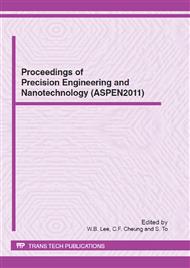p.192
p.198
p.203
p.209
p.215
p.222
p.228
p.234
p.240
Binder-Free Green Composite Using Bamboo Fibres Extracted with a Machining Centre: Influence of Moisture Absorption on Mechanical Properties
Abstract:
Bamboo grows faster than other renewable natural materials. Bamboo fibre, in particular, has attracted attention as an environmentally superior material. Therefore, we proposed a sustainable manufacturing system using bamboo. An extraction method of bamboo fibres end-milled using a machining centre with in-situ measurement was also proposed. Bamboo fibres with high precision shapes are efficiently acquired. Previously, we proposed the fabrication of binder-free composite by a hot press forming method that only uses bamboo fibres extracted by a machining centre. We experimentally demonstrated various hot press forming conditions and achieved proper ones to optimize the forming process. However, when the environment changes, the characteristics of the binder-free composite are not known. If we want to use the binder-free composite, we have to know how much it is affected by the external environment for use as a mechanical object. Therefore, we investigated the changes of the characteristics at high temperature and high humidity.
Info:
Periodical:
Pages:
215-221
Citation:
Online since:
June 2012
Authors:
Price:
Сopyright:
© 2012 Trans Tech Publications Ltd. All Rights Reserved
Share:
Citation:


